This project began as a collaborative study between Greg Schorr, Daniel Webster and Robin Baird of Cascadia Research, Brad Hanson of the Northwest Fisheries Science Center of the National Marine Fisheries Service, Russ Andrews of the University of Alaska Fairbanks and Alaska SeaLife Center, Dan McSweeney of the Wild Whale Research Foundation, and Jay Barlow of the Southwest Fisheries Science Center, National Marine Fisheries Service. The project has grown and evolved over the years, and we’ve worked with many collaborators on this research, deploying satellite tags on 12 different species of Hawaiian odontocetes. We’ve published a number of papers and reports on this work that are available on our publications page. The web page below, largely from our first couple of years of this work, primarily shows re-sighting photos of some of the species we’ve tagged.
Re-sighting photos of satellite tagged false killer whales from June/July 2008
Re-sighting photo of satellite tagged Cuvier’s beaked whale from October 2008
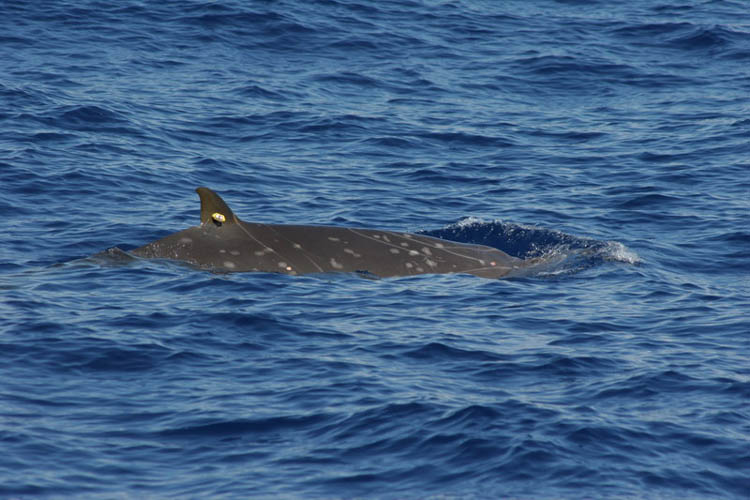
Adult male Blainville’s beaked whale with satellite tag. Photo (c) Robin W. Baird.
Tracking individuals using satellite or VHF tags can provide significant new information on movements and habitat use of difficult-to-observe groups such as cetaceans. Medium-sized cetaceans have posed a particular challenge for tagging as they are generally difficult-to-capture, as well as handle safely once captured. This has generally precluded the restraint of individuals for hand-application of dorsal-fin mounted tags, as is often done with small cetaceans (e.g., Hanson 2001; Hohn et al. 2007). In addition, the lack of a thick blubber layer, normally the site of attachment for dart type tags used with large whales, has limited tagging studies with medium-sized cetaceans. For large whales, dart type tags typically have most of the tag body and attachment mechanism implanted through the blubber into the muscle of the whale (e.g. Mate et al. 2007; Heide-Jorgenson et al. 2001a, 2001b). In recent years, Andrews et al (2005, 2008) developed a remotely-deployed tag for medium-size cetaceans that has the transmitter external to the body, with the attachment system the only portion of the tag that penetrates the skin. In order to provide the most structural stability and remain as minimally invasive as possible, tags are attached to the dorsal fin or dorsal ridge instead of the body.
Since 2006 we have been using these tags with six species of odontocetes in Hawaiian waters: short-finned pilot whales, false killer whales, melon-headed whales, pygmy killer whales, Blainville’s beaked whales and Cuvier’s beaked whales. The longest duration of attachment to date (October 2008) is from a false killer whale tagged in July 2008, with satellite locations received up to 76 days after tagging.
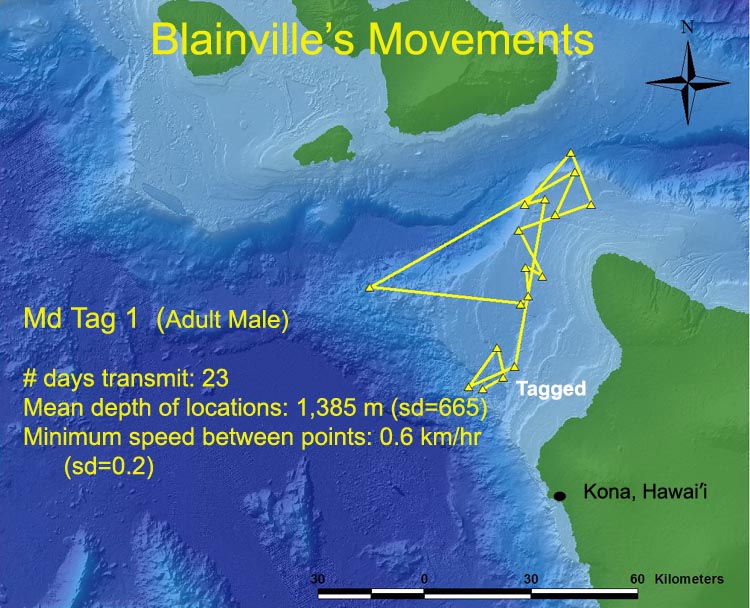
Locations of a satellite-tagged adult male Blainville’s beaked whale tracked over a 23 day period in 2006. This whale remained associated with the island (see McSweeney et al. 2007), but moved out of our study area off the west side of the island of Hawai‘i into the Alenuihaha Channel, an area typified by extremely rough sea states where detection of beaked whales would be difficult. From Schorr et al. (2007).
As part of this research we are attempting to obtain photographs of individuals in the days and weeks after tags have been attached, as well as after the tags have been shed, to assess the reasons why tags fail as well as wound healing. Between 2006 and May 2008 12 individual short-finned pilot whales were tagged. As of October 2008, 11 of those individuals have been re-sighted, with photographs showing healing of the tag sites.
Re-sightings of satellite tagged short-finned pilot whales
Shown below are two photographs of a tagged sub-adult male short-finned pilot whale, one on the day of tagging, and the second 244 days later, showing complete healing of the tag attachment site.

Sub-adult male short-finned pilot whale tagged with a VHF transmitter, November 30, 2006. Photo (c) Daniel Webster.
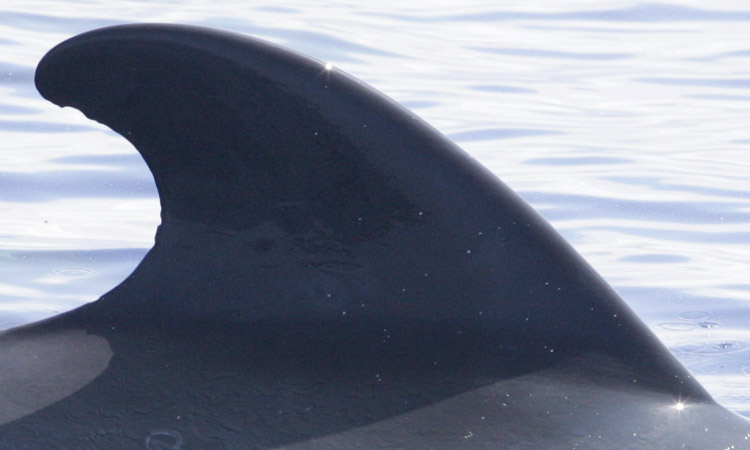
Sub-adult male short-finned pilot whale 244 days post-tagging, August 1, 2007. Photo (c) Dan McSweeney.
One individual pilot whale tagged on April 3, 2006 (first photo below), was re-tagged November 19, 2006. Upon examination of the photos taken November 19, we determined that this was the same individual tagged in April, with complete healing of the tag attachment sites.
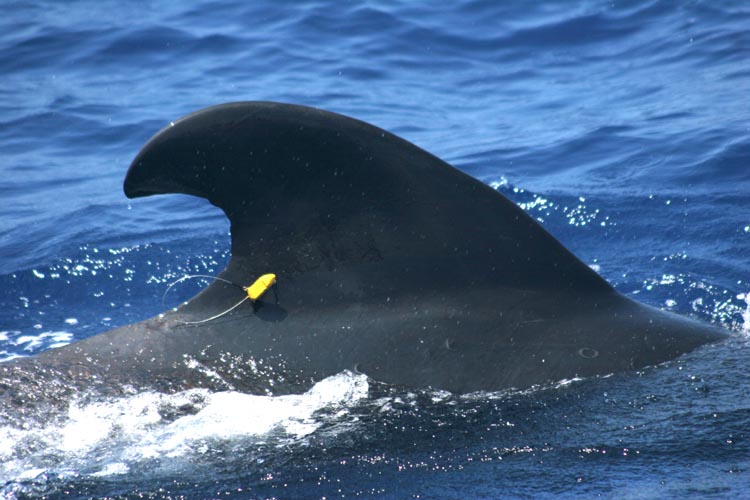
Adult male short-finned pilot whale tagged with a VHF transmitter, April 3, 2006. Photo (c) Daniel Webster.
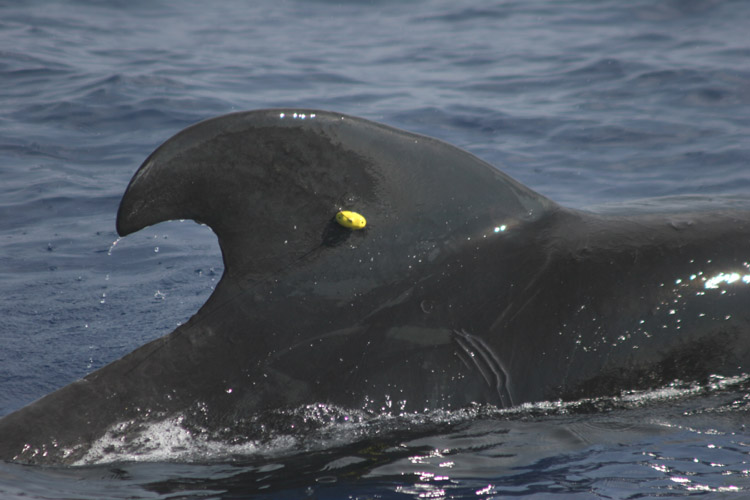
Adult male short-finned pilot whale tagged with a VHF transmitter on November 19, 2006. Attachment site from April 3, 2006 tagging is completely healed. Photo (c) Robin Baird.

Locations of two satellite-tagged adult males short-finned pilot whales tracked over 4 and 9 days in 2007. Both whales remained associated with the island, but moved out of our study area off the west side of the island of Hawai‘i into the Alenuihaha Channel, an area typified by extremely rough sea states where detection of whales would be difficult. From Schorr et al. (2007).
Re-sightings of satellite tagged false killer whales
In August 2007 we deployed satellite tags on three false killer whales. All three individuals were re-sighted in June and July 2008. Photos of these three individuals (before or immediately after tagging, as well as in June/July 2008) are shown below.

False killer whale HIPc107 with satellite tag, August 15, 2007. Photo (c) Daniel Webster.

False killer whale HIPc107 July 16, 2008. Photo (c) Dan McSweeney.

False killer whale HIPc217 August 15, 2007 showing location of tag attachment immediately prior to tagging. Photo (c) Jessica Aschettino.

False killer whale HIPc217 June 26, 2008. Photo (c) Dan McSweeney.

False killer whale HIPc276 with satellite tag, August 15, 2007. Photo (c) Daniel Webster.

False killer whale HIPc276 June 26, 2008. Photo (c) Dan McSweeney.
Re-sighting of satellite tagged Cuvier’s beaked whale

Cuvier’s beaked whale HIZc012 October 3, 2008. Photo (c) Doug Perrine. This adult female was satellite tagged November 30, 2006 (see report by Schorr et al. 2008, below). The tag was attached on the right side of the fin at the base, just posterior of the mid-point of the fin. Two faint white scars are visible at the sites where the darts were attached. The large oval white scars visible on the back of the whale and on the side of the fin (approximately 1/3rd of the way up from the base and in front of where the tag was attached) are healed scars caused by bites from cookie-cutter sharks. When seen in October 3, 2008, HIZc012 was accompanied by a calf, approximately a year-old, based on the number of cookie-cutter scars visible.
Presentations on this work:
We have published several papers on this work and have also presented information at several conferences and meetings. Citations/copies can be downloaded at the links below.
- Anderson, D., R.W. Baird, A.L. Bradford, and E.M. Oleson. 2020. Is it all about the haul? Pelagic false killer whale interactions with longline fisheries in the central North Pacific. Fisheries Research 230, 105665. https://doi.org/10.1016/j.fishres.2020.105665.
- Baird, R.W., and D.L. Webster. 2019. Movements of satellite-tagged pantropical spotted dolphins in relation to stock boundaries in Hawaiian waters. Document PSRG-2019-15 submitted to the Pacific Scientific Review Group, Olympia, WA. Download PDF copy
- Baird, R.W. 2019. Behavior and ecology of not-so-social odontocetes: Cuvier’s and Blainville’s beaked whales. In: Ethology and Behavioral Ecology of Toothed Whales and Dolphins, the Odontocetes. Edited by B. Würsig. Springer. For more information. Download PDF copy
-
Baird, R.W., G.S. Schorr, D.L. Webster, D.J. McSweeney, M.B. Hanson and R.D. Andrews. 2011. Movements of two satellite-tagged pygmy killer whales (Feresa attenuata) off the island of Hawai‘i. Marine Mammal Science 27:E332-E337 Download PDF copy
-
Baird, R.W., G.S. Schorr, D.L. Webster, D.J. McSweeney, M.B. Hanson and R.D. Andrews. 2010. Movements and habitat use of satellite-tagged false killer whales around the main Hawaiian Islands. Endangered Species Research 10:107-121. Download PDF copy
-
Baird, R.W., G.S. Schorr, D.L. Webster, D.J. McSweeney, M.B. Hanson and R.D. Andrews. 2010. Movements and habitat use of Cuvier’s and Blainville’s beaked whales in Hawai‘i: results from satellite tagging in 2009/2010. Report prepared under Order No. AB133F09SE4843 from the Southwest Fisheries Science Center, La Jolla, CA. Download PDF copy
-
Schorr, G.S., R.W. Baird, M.B. Hanson, D.L. Webster, D.J. McSweeney and R.D. Andrews. 2009. Movements of satellite-tagged Blainville’s beaked whales off the island of Hawai‘i. Endangered Species Research 10:203-213. Download PDF copy
-
Baird, R.W., G.S. Schorr, D.L. Webster, S.D. Mahaffy, D.J. McSweeney, M.B. Hanson, and R.D. Andrews. 2009. Movements of satellite-tagged Cuvier’s and Bainville’s beaked whales in Hawai‘i: evidence for an offshore population of Blainville’s beaked whales. Report prepared under Contract No. AB133F-08-SE-4534 from the Southwest Fisheries Science Center, National Marine Fisheries Service, La Jolla, California. Download PDF copy
-
Baird, R.W., G.S. Schorr, D.L. Webster, D.J. McSweeney, M.B. Hanson, and R.D. Andrews. 2008. Movements of satellite-tagged false killer whales around the main Hawaiian Islands. Document PSRG-2008-13 submitted to the Pacific Scientific Review Group, Kihei, HI, November 2008. Download PDF copy
-
Baird, R.W., D.J. McSweeney, G.S. Schorr, S.D. Mahaffy, D.L. Wester, J. Barlow, M.B. Hanson and R.D. Andrews. 2007. Site fidelity and movements of Cuvier’s and Blainville’s beaked whales at three spatial/temporal scales: combining VHF radio tracking, satellite tagging and long-term photo-identification. Presentation at the 21st Annual conference of the European Cetacean Society, San Sebastian, Spain, April 24, 2007. Download PDF copy of abstract
-
Schorr, G.S., R.W. Baird, D.L. Webster, D.J. McSweeney, M.B. Hanson, R.D. Andrews and J. Barlow. 2007. Spatial distribution of Blainville’s beaked whales, Cuvier’s beaked whales, and short-finned pilot whales in Hawai‘i using dorsal fin-attached satellite and VHF tags: implications for management and conservation. Talk presented at the 17th Biennial Conference on the Biology of Marine Mammals, Cape Town, South Africa, November-December 2007. Download PDF copy of abstract
-
Schorr, G.S., R.W. Baird, M.B. Hanson, D.L. Webster, D.J. McSweeney, and R.D. Andrews. 2008. Movements of the first satellite-tagged Cuvier’s and Blainville’s beaked whales in Hawai‘i. Report prepared under Contract No. AB133F-07-SE-3706 to Cascadia Research Collective, Olympia, WA from the Southwest Fisheries Science Center, National Marine Fisheries Service, La Jolla, California. Download PDF copy
References
Andrews, R.A., C.O. Matkin, and L. Mazzuca. 2005. Satellite tags and attachment techniques for killer whales. In Abstracts of the 16th Biennial Conference on the Biology of Marine Mammals, 12-16 December 2005, San Deigo, CA. p. 15.
Andrews, R.D., R.L. Pitman and L.T. Ballance. 2008. Satellite tracking reveals distinct movement patterns for Type B and Type C killer whales in the southern Ross Sea, Antarctica. Polar Biology. DOI 10.1007/s00300-008-0487-z. Download PDF copy
Hanson, M.B. 2001. An evaluation of the relationship between small cetacean tag design and attachment durations: a bioengineering approach. Ph.D. dissertation, Univ. of Washington, Seattle, WA. 208 pp. Download PDF copy (3.7 meg file)
Hohn, A.A., M.B. Hanson, F.Townsend, F. Deckert and T. Similä. 2007. Failure modes of dorsal fin-mounted small cetacean telemetry tags. Pp. 33-34 in Sheridan, P., J. W. Ferguson, and S. L. Downing (editors). Report of the National Marine Fisheries Service workshop on advancing electronic tag technologies and their use in stock assessments. U.S. Dept. Commerce, NOAA Tech. Memo. NMFSF/ SPO-82, 82 p.
Heide-Jørgensen, M.-P., L. Kleivane, N. Oien, K.L. Laidre and M.V. Jensen. 2001a. A new technique for deploying satellite transmitters on baleen whales: tracking a blue whale (Balaenoptera musculus) in the North Atlantic. Marine Mammal Science 17:949-954.
Heide-Jørgensen, M.P., E.S. Nordøy, N. Øien, L.P. Folkow, L. Kleivane, A.S. Blix, M.V. Jensen and K.L. Lairde. 2001b. Satellite tracking of minke whales (Balaenoptera acutorostrata) off the coast of northern Norway. Journal of Cetacean Research and Management 3:175-178.
Mate, B., R. Mesecar, and B. Lagerquist. 2007. The evolution of satellite-monitored radio tags for large whales: One laboratory’s experience. Deep-Sea Research II 54:224-247.
McSweeney, D.J., R.W. Baird and S.D. Mahaffy. 2007. Site fidelity, associations and movements of Cuvier’s (Ziphius cavirostris) and Blainville’s (Mesoplodon densirostris) beaked whales off the island of Hawai‘i. Marine Mammal Science 23:666-687.
Pitman, R.L., R. Andrews and L.T. Balance. 2007. Tracking cold killers: Satellite telemetry reveals movement pattern variation between two different ecotypes of Antarctic killer whales. In Abstracts of the 17th Biennial Conference on the Biology of Marine Mammals, 29 November to 3 December 2007, Cape Town , South Africa.
Acknowledgements
Tag development and acquisition has been funded by Stock Assessment Improvement funds from the Northwest Fisheries Science Center of NOAA Fisheries, by the U.S. Navy (via the Southwest Fisheries Science Center and WHOI), and from a grant from Dolphin Quest. Field research has been funded by the Southwest Fisheries Science Center, US Navy (N45), and Wild Whale Research Foundation. We would like to thank Lloyd Murrey and John Ellman for help with tag development and construction. Tagging has been undertaken under NMFS Scientific Research Permits No. 774-1714 (issued to the Southwest Fisheries Science Center) in April 2006, No. 782-1719 (issued to the National Marine Mammal Laboratory) in November 2006, and No. 731-1509 (issued to R.W. Baird) in 2007 and 2008.
For more information on this research write to: rwbaird (at) cascadiaresearch.org or gschorr (at) cascadiaresearch.org or go to the Cascadia Research Hawai‘i page
Updated October 2009